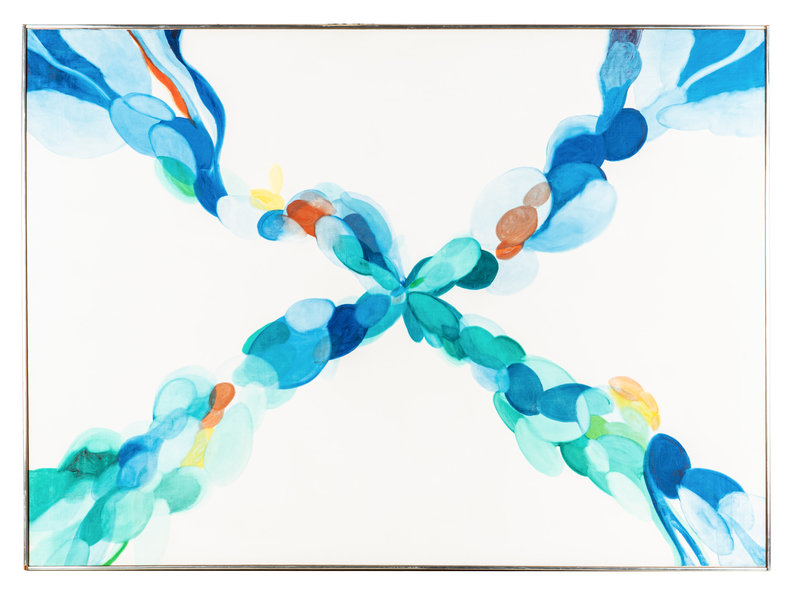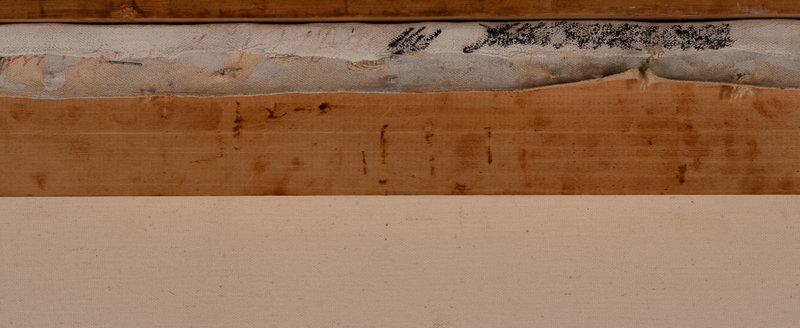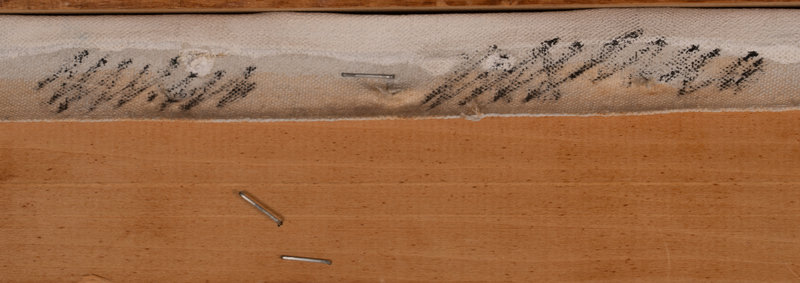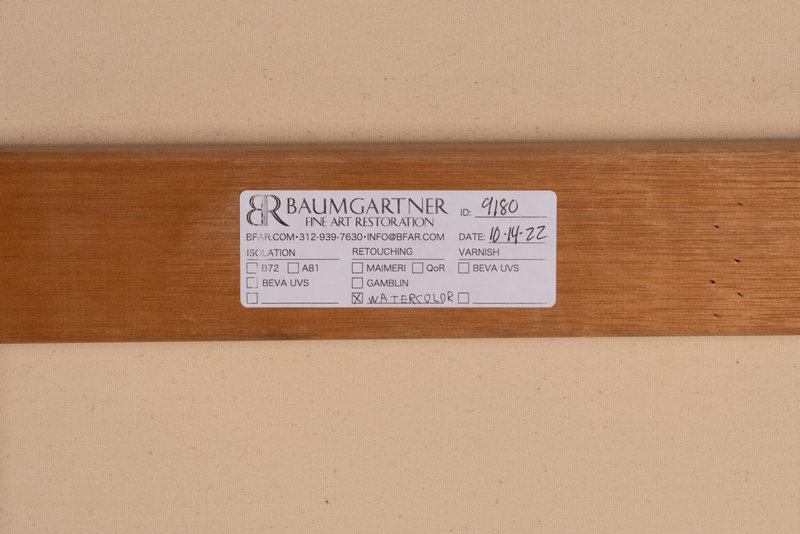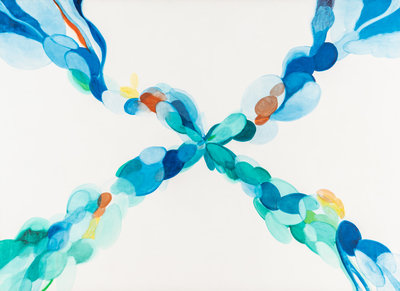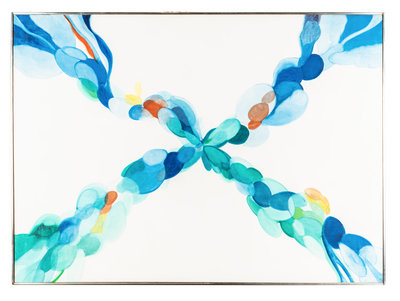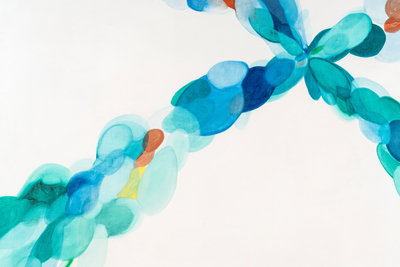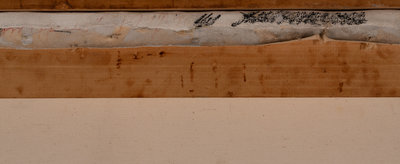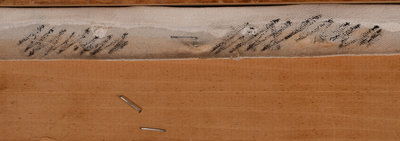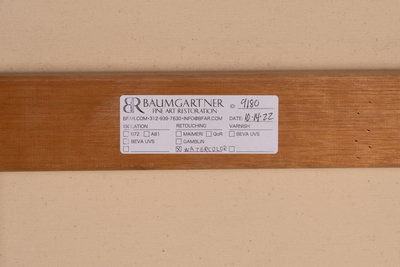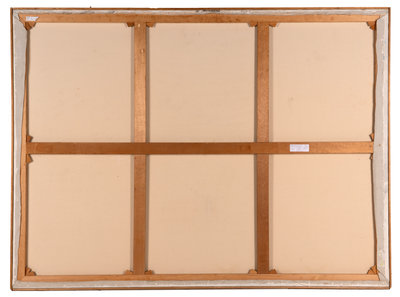Alice Baber
(American, 1928-1982)
Olympus, 1970-71
Sale 1114 - Post-War & Contemporary Art
Dec 14, 2022
10:00AM CT
Live / Chicago
Own a similar item?
Estimate
$20,000 -
30,000
Price Realized
$50,000
Sold prices are inclusive of Buyer’s Premium
Lot Description
Alice Baber
(American, 1928-1982)
Olympus, 1970-71
watercolor on canvas
signed Alice Baber, titled, and dated (verso)
58 1/8 x 75 5/8 inches.
Lot Essay:
Color Hunger
My own point of view leaned heavily to the pre-eminence of color – what I call “color hunger” – that has motivated my own work and my selections. I have also looked for magic, poetry, eccentricity, saturation, overemphasis, and so forth.
-- Alice Baber in Curators Notes for the show Color Forum at the University Art Museum, The University of Texas at Austin
Alice Baber was born in 1928 in Charleston, Illinois, and enjoyed a nomadic childhood split between her family home and Florida, instilling a love of travel that would inspire her career. Baber began drawing at eight, enrolled in a college art class by twelve, had her first solo show at 30, and, by the time of her death at age fifty-four, was a widely respected artist and curator whose work was represented in major collections internationally.
The trajectory of Baber’s career mirrors many of her contemporaries: peripatetic youth, education interrupted by World War II, a stint in Paris, and then a shift to New York . Her deep-rooted interest in Asian culture was encouraged by a 1964 show with the Gutai Group in Japan alongside her then-husband, fellow artist Paul Jenkins. She was especially enamored with cultural uses of color and spiritual mysticism, developing an impressive personal collection throughout her travels.
Color was everything for Baber.
“Anything you remember well you remember in very vivid color, and anything that’s particularly sort of gloomy becomes very gray,” she said in an interview with the Smithsonian Archives of American Art (Oral history interview with Alice Baber, May 24, 1973). “This has nothing to do with dreaming in color; that’s something else. Either one does or one doesn’t. My most interesting memories are in very brilliant color. I remember a day when I was four that it rained and it was green, everything. The rain was green, everything was green. And I remember looking at a sea shell when I was about three and everything was yellow. The whole world. And I think other people probably have somewhat similar feelings about color environment.”
She referred to these phenomena as color-hunger, her kind of preternatural yearning to use and understand color in ways both concrete and atmospheric throughout her work. It’s almost as if she was able to see a broader spectrum of colors than most and was desperate to describe them -- translating an unknowable language.
Olympus is an excellent example of Baber’s work: the balance of positive and negative space became increasingly important to her in the prime of her career, evidenced here in strong, fluid forms set against a stark white background, the vivid purples and blues fluctuating in opacity as if turning a kaleidoscope.
“I use the white ground in a number of ways,” she said in her Smithsonian interview, “I often paint a painting until it tells me to stop, and sometimes the white ground still shows. In most cases, I try to make the white ground either a pattern, so that it can be both negative and positive space, or if not that perhaps and atmospheric wind moving the other colors and shapes around… but if it doesn’t happen to appear, that’s all right, too.”
We are pleased to present Olympus contextualized in this sale with the work of many of Baber’s fellow artists: Balcom Greene (who she praised for his ability to “attack the figures with light”), Gene Davis and Robert Natkin, both of whom she included in her show Color Forum at the University Art Museum at the University of Texas at Austin in 1972, and her ex-husband, Paul Jenkins. Though Baber and Jenkins both explored color in their abstractions, Baber’s refined forms and careful layers of paint were contrasted by his fluid pourings. Though during their time Jenkins was perhaps the more recognized name, the recent interest in Baber’s work has accelerated her auction record to eclipsing his.
After painting through several grueling years of cancer, Baber’s career was cut short when she died in 1982 at just 54 years of age. An ardent self-professed feminist, she curated a show of women’s work called Color, Light and Image in 1972, and had put together several other shows in the years that followed. Her accelerated career – and talent – has indeed left us all with an insatiable color hunger.
Color Hunger
My own point of view leaned heavily to the pre-eminence of color – what I call “color hunger” – that has motivated my own work and my selections. I have also looked for magic, poetry, eccentricity, saturation, overemphasis, and so forth.
-- Alice Baber in Curators Notes for the show Color Forum at the University Art Museum, The University of Texas at Austin
Alice Baber was born in 1928 in Charleston, Illinois, and enjoyed a nomadic childhood split between her family home and Florida, instilling a love of travel that would inspire her career. Baber began drawing at eight, enrolled in a college art class by twelve, had her first solo show at 30, and, by the time of her death at age fifty-four, was a widely respected artist and curator whose work was represented in major collections internationally.
The trajectory of Baber’s career mirrors many of her contemporaries: peripatetic youth, education interrupted by World War II, a stint in Paris, and then a shift to New York . Her deep-rooted interest in Asian culture was encouraged by a 1964 show with the Gutai Group in Japan alongside her then-husband, fellow artist Paul Jenkins. She was especially enamored with cultural uses of color and spiritual mysticism, developing an impressive personal collection throughout her travels.
Color was everything for Baber.
“Anything you remember well you remember in very vivid color, and anything that’s particularly sort of gloomy becomes very gray,” she said in an interview with the Smithsonian Archives of American Art (Oral history interview with Alice Baber, May 24, 1973). “This has nothing to do with dreaming in color; that’s something else. Either one does or one doesn’t. My most interesting memories are in very brilliant color. I remember a day when I was four that it rained and it was green, everything. The rain was green, everything was green. And I remember looking at a sea shell when I was about three and everything was yellow. The whole world. And I think other people probably have somewhat similar feelings about color environment.”
She referred to these phenomena as color-hunger, her kind of preternatural yearning to use and understand color in ways both concrete and atmospheric throughout her work. It’s almost as if she was able to see a broader spectrum of colors than most and was desperate to describe them -- translating an unknowable language.
Olympus is an excellent example of Baber’s work: the balance of positive and negative space became increasingly important to her in the prime of her career, evidenced here in strong, fluid forms set against a stark white background, the vivid purples and blues fluctuating in opacity as if turning a kaleidoscope.
“I use the white ground in a number of ways,” she said in her Smithsonian interview, “I often paint a painting until it tells me to stop, and sometimes the white ground still shows. In most cases, I try to make the white ground either a pattern, so that it can be both negative and positive space, or if not that perhaps and atmospheric wind moving the other colors and shapes around… but if it doesn’t happen to appear, that’s all right, too.”
We are pleased to present Olympus contextualized in this sale with the work of many of Baber’s fellow artists: Balcom Greene (who she praised for his ability to “attack the figures with light”), Gene Davis and Robert Natkin, both of whom she included in her show Color Forum at the University Art Museum at the University of Texas at Austin in 1972, and her ex-husband, Paul Jenkins. Though Baber and Jenkins both explored color in their abstractions, Baber’s refined forms and careful layers of paint were contrasted by his fluid pourings. Though during their time Jenkins was perhaps the more recognized name, the recent interest in Baber’s work has accelerated her auction record to eclipsing his.
After painting through several grueling years of cancer, Baber’s career was cut short when she died in 1982 at just 54 years of age. An ardent self-professed feminist, she curated a show of women’s work called Color, Light and Image in 1972, and had put together several other shows in the years that followed. Her accelerated career – and talent – has indeed left us all with an insatiable color hunger.
Condition Report
Auction Specialist

